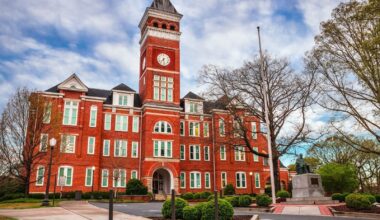Aerospace engineering is a field that captivates the imagination of many, as it involves designing and building aircraft, spacecraft, and cutting-edge technologies that push the boundaries of human exploration. Aspiring aerospace engineers seek out the finest institutions that can provide them with a solid foundation in engineering principles, access to advanced research facilities, and opportunities to work on groundbreaking projects. In this article, we delve into the best aerospace engineering schools, renowned for their academic excellence, distinguished faculty, and contributions to the aerospace industry.
- Massachusetts Institute of Technology (MIT): MIT’s Department of Aeronautics and Astronautics is a pioneering force in aerospace engineering education. With a strong focus on research, students benefit from working alongside renowned faculty and have access to state-of-the-art laboratories.
- Stanford University: Stanford’s Department of Aeronautics and Astronautics offers a comprehensive curriculum that combines theoretical knowledge with hands-on experience. The school’s location in Silicon Valley opens doors to industry partnerships and innovation.
- California Institute of Technology (Caltech): Caltech’s Graduate Aerospace Laboratories (GALCIT) are celebrated for their contributions to aerospace research and education. The institute’s small class sizes and collaborative atmosphere foster close faculty-student interactions.
- Georgia Institute of Technology (Georgia Tech): Georgia Tech’s Daniel Guggenheim School of Aerospace Engineering is known for its diverse research areas and emphasis on industry partnerships. The school’s strong ties to the aerospace industry offer excellent internship and job opportunities.
- University of Michigan: The University of Michigan’s Aerospace Engineering program is renowned for its cutting-edge research and focus on aerospace systems and technologies. Students gain practical experience through numerous aerospace-related projects.
- Purdue University: Purdue’s School of Aeronautics and Astronautics boasts a long history of excellence in aerospace engineering. The school’s extensive research facilities and renowned faculty attract aspiring engineers from around the world.
- University of Illinois Urbana-Champaign (UIUC): UIUC’s Department of Aerospace Engineering offers a dynamic learning environment with a balance between theoretical coursework and hands-on research opportunities. The school’s strong industry connections provide valuable exposure to real-world challenges.
- University of Texas at Austin: The Aerospace Engineering program at UT Austin is known for its multidisciplinary approach and research in cutting-edge aerospace technologies. The school’s strong emphasis on innovation prepares students for leadership roles in the industry.
- University of Maryland, College Park: UMD’s Department of Aerospace Engineering excels in research and innovation. Students benefit from access to a robust aerospace research community and the opportunity to work on projects with real-world applications.
- Texas A&M University: Texas A&M’s Aerospace Engineering program offers a comprehensive curriculum with a focus on aerospace design and propulsion. The school’s strong emphasis on hands-on learning prepares students for successful careers in the aerospace industry.
How to apply for fully funded scholarships in any Aerospace Engineering School in USA
Applying for fully funded scholarships in Aerospace Engineering schools in the USA requires careful planning, research, and attention to detail. Follow these steps to increase your chances of securing a fully funded scholarship:
- Research Scholarships: Start by researching fully funded scholarships offered by various Aerospace Engineering schools in the USA. Visit the official websites of universities and aerospace organizations to find scholarship opportunities tailored to international students.
- Check Eligibility Criteria: Review the eligibility criteria for each scholarship to ensure you meet the requirements. These criteria may include academic achievements, English language proficiency, standardized test scores (e.g., SAT, ACT, GRE), and specific qualifications related to Aerospace Engineering.
- Identify Suitable Programs: Shortlist Aerospace Engineering programs that align with your academic and career goals. Consider factors like the program’s reputation, faculty expertise, research opportunities, and available facilities.
- Prepare Required Documents: Organize all the necessary documents for your scholarship application. Commonly required documents include academic transcripts, letters of recommendation, a statement of purpose (SOP), a resume or CV, and standardized test scores.
- Craft a Compelling SOP: Your statement of purpose is a crucial part of the application process. Tailor it to showcase your passion for Aerospace Engineering, your academic achievements, and how the scholarship will help you achieve your career aspirations.
- Secure Strong Recommendations: Obtain recommendation letters from teachers, professors, or supervisors who can attest to your academic abilities and potential. Ensure these recommendations highlight your suitability for the scholarship and your chosen program.
- Take Standardized Tests: If required, take standardized tests like the GRE (Graduate Record Examination) and TOEFL/IELTS (for English proficiency). Aim for scores that meet or exceed the scholarship’s minimum requirements.
- Apply Early: Submit your scholarship application well before the deadline. Applying early demonstrates your enthusiasm and commitment to the program.
- Seek Financial Aid Offices: Reach out to the financial aid offices of the Aerospace Engineering schools you are applying to. They can provide guidance on available scholarships, financial aid packages, and the application process.
- Stay Organized: Keep track of all application deadlines and requirements. Create a checklist to ensure you have completed all necessary steps.
- Proofread Your Application: Before submitting your application, carefully review all documents for errors or omissions. A polished application reflects positively on your attention to detail.
- Prepare for Interviews: Some scholarships may require interviews as part of the selection process. Practice common interview questions and be prepared to discuss your academic and career goals.
Remember, fully funded scholarships for Aerospace Engineering programs are highly competitive. Apart from academic excellence, showcase your passion for the field, leadership skills, and the impact you wish to make in the aerospace industry. With determination, thorough preparation, and a strong application, you can increase your chances of securing a fully funded scholarship to study Aerospace Engineering in the USA.
Conclusion
Selecting the right aerospace engineering school is a critical step towards realizing one’s dream of contributing to the field of aerospace technology. The best aerospace engineering schools listed above have earned their esteemed reputation through their commitment to academic excellence, advanced research initiatives, and strong industry partnerships. When choosing an aerospace engineering school, aspiring engineers should consider factors such as faculty expertise, research opportunities, access to advanced laboratories, and the school’s location.
Ultimately, it is the passion, dedication, and thirst for knowledge that will drive aspiring aerospace engineers to new heights in their careers. Embrace the challenges, seize the opportunities, and embark on a journey to launch your dreams into the stratosphere of aerospace engineering.





